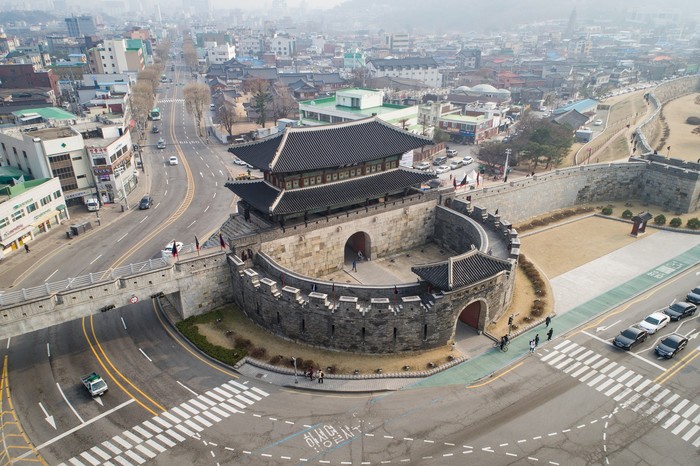
[The Public = Daniel Park] Suwon is a historic site with Suwon Hwaseong, designated as a UNESCO World Heritage Site as the capital of Gyeonggi Province. Suwon-city, the center of Gyeonggi-do, is the place where you can best feel the culture of Gyeonggi-do. The main attractions are concentrated in Suwon Hwaseong Fortress, so Suwon is characterized by saving travel time compared to other cities. Historical tourism has been developed centered on Suwon Hwaseong Fortress, and city tourism such as various food alleys, walking trails, traditional markets and large commercial areas is also very developed. With the creation of Gwanggyo New Town, you can enjoy city tourism that is different from the downtown area in this area. I would like to introduce 10 tourist attractions in Hwaseong, which are good for a day trip as they are close to Seoul.
1. Suwon Hwaseong
Suwon Hwaseong Fortress, a representative historical site in Suwon, is a 5.52km-long fortress that spans Paldal-gu and Jangan-gu. It was designated as Historic Site No. 3 in 1963 and was registered as a UNESCO World Heritage Site in 1997. Construction began in 1794 during the reign of King Jeongjo of the Joseon Dynasty and was completed in 1796. It is also famous for using the geojunggi designed by Dasan Jeong Yak-yong. It was designated as a UNESCO World Heritage Site in 1997.
Hwaseong has four gates: South Gate, West Gate, North Gate, and East Gate. Janganmun is the north gate and main gate of Hwaseong, Janganmun is the south gate of Hwaseong, Changnyongmun is the east gate of Hwaseong, and Hwaseomun is the west gate of Hwaseong. Suwon Hwaseong Fortress is evaluated as the most unique structure in the history of Korean fortress architecture where you can examine the science, architecture, and art of the 18th century, such as the invention and use of new materials such as geojunggi, pull wheel, and potter's wheel, and the construction method that integrated Eastern and Western fortification techniques.
Even today, it retains its old look, and if you have time, it is recommended to take a tour of the entire Fortress Dulle-gil. If you walk slowly, it will take about 3 hours.
2. Hwaseong Haenggung Palace
Haenggung refers to a place where the king temporarily stays when he moves in a province, or where a separate palace is set up in the province to temporarily reside. Hwaseong Haenggung Palace was built in the 13th year of King Jeongjo (1789), when the tomb of Prince Sado, the father of King Jeongjo, was moved to the site of the township of Suwonbu, and the original township of Suwonbu was moved under Paldalsan Mountain to be used as a government office. It was also used as a palace for the king to stay when he came down to Suwon.
Hwaseong Haenggung Palace has the most outstanding scale and formality among the Haenggung Palaces built throughout the country during the Joseon Dynasty. Hwaseong Haenggung started to be used as a hospital and police station in 1911 during the Japanese colonial period, and most of them were destroyed as hospital buildings were built in the 1920s. Currently, only Naknamheon and Songdang have maintained their original appearance.
Currently, Hwaseong Haenggung is a place where you can feel the history. There are many old buildings and pretty cafes, so it is a good place for a date or a family outing.
3. Banghwa-su-ryu-jeongg Pavilion
There are four pavilions in Suwon Hwaseong Fortress: Dongbukgaknu, Seobukgaknu, Westnamgaknu, and Dongnamgaknu. The southwestern pavilion is called Hwayangnu, and the northeast pavilion is called Banghwasuryujeong. A corner pavilion, called gangnu in Korean, was built on the high ground of the fortress to watch the surrounding area and to be used for leisure. The name comes from the fact that there is one such pavilion at each of the four corners of Hwaseong Fortress.
The Northeastern Corner Pavilion is an L-shaped building with a sophisticated and complex roof design. It is commonly known by the name “Banghwasuryujeong (訪花隨柳亭).” The pavilion overlooks a large pond, and the harmony of the pavilion and its beautiful surroundings is the most outstanding among the various structures in Hwaseong Fortress.
Originally, the pavilion was built as a command center, but over time, it came to be used as a place for enjoying the scenery rather than for military purposes. The pavilion was dismantled to be rebuilt in 1934.
It shows the characteristics of Jeongja architecture in the Joseon Dynasty that is in harmony with the surrounding landscape while being faithful to the military purpose of monitoring and commanding the surroundings. Although it is small, the view along with the castle is beautiful. The night view is especially beautiful, so it is good to visit at night.
4. Yeonmudae
A command post, called jangdae in Korean, is the center from which a military commander would direct soldiers during military drills and war. In Hwaseong Fortress, there are two command posts: one in the western section and one in the eastern section.
The Eastern Command Post was where regular military training was conducted. Its nickname, “Yeonmudae (鍊武臺),” means “place for training martial arts.” In front of the building is a three-level courtyard, where soldiers would stand depending on their position. Between the lowest and the middle level, a ramp, instead of a stairway, was installed for horses and mounted soldiers. At the completion of the construction of Hwaseong Fortress in 1796, a large banquet was held in this courtyard for the more than 2,700 people who participated in the construction.
Although the terrain here is not high, it is open on all sides and has a towering ridge, making it the best place to view the inside of the castle from the east of Hwaseong. At Yeonmudae, you can walk through the castle walls, experience the national archery, and ride a Hwaseong fisherman.
[Image by Pixabay]
The Public / Daniel Park webmaster@thepublic.kr
더퍼블릭 / Daniel Park webmaster@thepublic.kr
